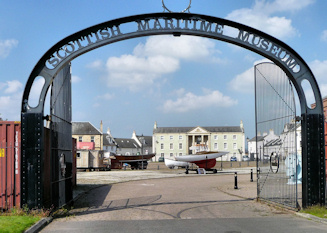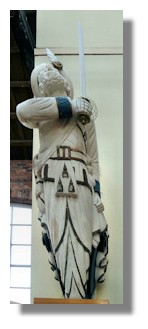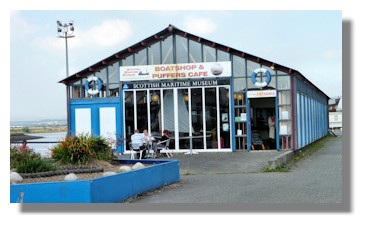Scottie's Diary
- Scottish Maritime Museum, Irvine
City of Adelaide
Like most Glaswegians of my generation I became very familiar with the sailing vessel "Carrick" when it was moored on the river Clyde in Glasgow for 40 years as the headquarters of the Royal Naval Volunteer Reserve (RNVR). It was only later, in 1990, that I learned that the ship had originally been launched in 1864 as the "City of Adelaide" - and had immediately cut the journey time to Australia from 100 days to 65. The ship was an important vessel taking emigrants from the UK to South Australia, but when the RNVR found that it was too expensive to continue using it as a floating HQ, she was moved to the Scottish Maritime Museum at Irvine where she has lain, slowly rotting away, ever since. The Museum has been unable to raise funding for restoration and, despite its historic importance, the museum trustees initially applied for permission to destroy the wooden ship in "a very big bonfire". Later, after campaigning by a group in Adelaide in particular, that was changed to "deconstruction" - essentially breaking up the ship to learn more about its original construction, but leaving behind a pile of wood. This sailing ship is now the oldest surviving clipper ship in the world (even older than the better known "Cutty Sark" in London) and surely deserved better!
Over the last ten years, the city of Sunderland (where the ship was built) and the city of Adelaide in South Australia (the port where it took so many emigrants in the 19th century) have competed to take over the ship. Recently, the Scottish Minister for Culture and External Affairs has named the Australian Group, The Clipper Ship, City of Adelaide, as the preferred bidder to move this internationally important vessel to South Australia. The aim is to take the ship to Adelaide in time for the 175th anniversary of South Australia's settlement on December 26 next year. That will cost around five million Australian dollars. Thereafter it is hoped to obtain funding to preserve the ship and turn it into a major tourist attraction and a reminder of the heritage of South Australia and its links with the UK.
Ever since the days of the "Scottish Snippets" newsletter, I have followed the story of the ship with great interest but although I had seen photos of the venerable sailing ship, I had never travelled to the Scottish Maritime Museum at Irvine to see it for myself. With the prospect of it being moved to the other side of the world, I thought it was time to rectify that and set off for Irvine in Ayrshire.
Scottish Maritime Museum, Irvine
The first surprise at the museum in Irvine was to find that the building had originally been the engine shop at a shipyard on the Clyde at Linthouse. it had been moved, brick by brick and girder by girder to be re-erected at Irvine. Described as Scotland’s ‘Cathedral of Engineering’ the Victorian Glass-roofed building dates from 1872. The huge building houses a large collection of boats of various sizes - the largest is a lifeboat once operated by the RNLI (Royal National Lifeboat Institution) the charity that provides rescue services around the coast of the UK.
Although the focus of the museum is on boats, the connection with the Denny shipyard on the Clyde has meant that the building also houses other relics from that Dumbarton based company. In particular, there is a strange-looking helicopter with propellers providing lift. Test flights were made in 1908 and it became airborne under its own power in September 1912. It is believed to be the first helicopter in the world to do so. However, the outbreak of World War I brought development to a halt.
Towering over the displays in the museum are three large figureheads from ships that have long gone. The largest is "The Prince of Wales" but the other two are pretty big also - the "Claymore" and "Resistance". As with all the other exhibits in the museum, there are interesting and comprehensive information boards giving their history and backgrounds. The "Claymore" for example was a steamer that worked for 50 years on the long route from Glasgow to Stornoway in the Western Isles. With a fine hull, clipper bow and figurehead she looked more like a yacht than a working passenger and cargo steamer. In the 1930s, when the ship was sent to the breakers yard, people wrote from all over the world asking for souvenirs. The figurehead was acquired by a retired military man in Forfar and graced the garden of his house for many years, before being acquired by the Scottish Fisheries Museum in Anstruther before coming to the Maritime Museum at Irvine.I've taken a large selection of pictures from the Maritime Museum and created a slide show of these on YouTube, thus making it accessible to all PC platforms.
The Carrick
It was disappointing to find that the ship that I had known all those years ago as the "Carrick" was stored in the open air, away from the main museum. While it was possible to see bits of it (with tarpaulins over some of the deck to stop the rain getting in to the lower decks) it was at a distance behind a locked gate and there were some buildings in the way making photography almost impossible. Since visiting Irvine, I've looked at the site using Google's satellite picture overlay and I think there may be a way of getting beyond the ship and getting a photo from the other side. Then again, I may get arrested for trespassing!
Puffers Café
In a separate building from the museum is the Puffers Café which has been recently upgraded and improved. You don't need to be a paying visitor to access the café which overlooks the river Irvine. There are some boats belonging to the museum parked there, including the harbour tug Garnock, and Carola, a steam yacht built in 1898. Inside, there are some models of ships including one of the Cutty Sark. The café is "waitress service" and has an excellent selection of snacks and meals. I enjoyed a first class macaroni and cheese and chips (French fries). The venue is very busy at lunch time as the locals as well as tourists clearly use it often.
More Information
The Scottish Maritime Museum has its own Web site which covers the four locations owned by the trust - "Clydebuilt" beside the shopping centre at Braehead in Renfrew, the Denny Tank at Dumbarton (the world’s first commercial ship model experimental tank, the length of a football pitch) and Irvine.
See also the Google Location Map (you can enlarge the scale of this map, if required).
For more on the "City of Adelaide" and the project to bring this ship to South Australia, see Clipper Ship City of Adelaide and the Scottish Maritime Museum page on the project.
If you want to read the other Diary entries going back to 2009, there is an Index page.
Where else would you like to go in Scotland?






